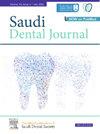Current applications and future perspective of virtual reality in dental education and practice in Saudi Arabia: A scoping review
IF 2.3
Q3 DENTISTRY, ORAL SURGERY & MEDICINE
引用次数: 0
Abstract
Objective
This scoping review aimed to evaluate the current state of virtual reality (VR) implementation in dental education and practice in Saudi Arabia, highlighting its advantages and challenges.
Methods
A scoping review examined VR’s role in regrading dental education and practice in Saudi Arabia by searching electronic databases, including PubMed, Web of Science, and Scopus, from inception to July 2024. Studies including VR applications for education, skills development, or anxiety/pain management involving Saudi dental students and practitioners were included.
Results
Eleven relevant studies were identified: 5 focused on education and 6 on clinical practice. Educational studies showed mixed effectiveness of VR versus traditional methods but positive student perceptions. Clinical application studies also had mixed results on VR’s impact on anxiety and pain, though some benefits were noted. VR systems included distraction-based, simulator-based, and hybrid VR/augmented reality with artificial intelligence.
Conclusion
While the current implementation of VR in dental practice in Saudi Arabia shows promise, particularly in enhancing students’ engagement and reducing patients’ anxiety, more comprehensive and robust research is needed to validate its effectiveness fully. Strategic efforts should focus on expanding research, tailoring applications, and integrating VR with traditional methods to align with the healthcare objectives of Vision 2030.
虚拟现实技术在沙特阿拉伯牙科教育和实践中的当前应用和未来展望:范围审查
目的本范围界定综述旨在评估虚拟现实(VR)在沙特阿拉伯牙科教育和实践中的实施现状,突出其优势和挑战。方法范围界定综述通过搜索电子数据库,包括PubMed、Web of Science和Scopus,研究了VR在沙特阿拉伯牙科教育和实践中的作用。研究内容包括将 VR 应用于教育、技能开发或焦虑/疼痛管理,涉及沙特的牙科学生和从业人员:结果发现了七项相关研究:五项侧重于教育,六项侧重于临床实践。教育研究显示,VR 与传统方法相比效果不一,但学生的看法是积极的。关于 VR 对焦虑和疼痛的影响,临床应用研究的结果也不尽相同,但也注意到了一些益处。结论虽然目前在沙特阿拉伯的牙科实践中实施 VR 显示出了前景,特别是在提高学生参与度和减少患者焦虑方面,但还需要更全面、更有力的研究来充分验证其有效性。战略工作应侧重于扩大研究、定制应用以及将 VR 与传统方法相结合,以符合《2030 年远景规划》的医疗保健目标。
本文章由计算机程序翻译,如有差异,请以英文原文为准。
求助全文
约1分钟内获得全文
求助全文
来源期刊

Saudi Dental Journal
DENTISTRY, ORAL SURGERY & MEDICINE-
CiteScore
3.60
自引率
0.00%
发文量
86
审稿时长
22 weeks
期刊介绍:
Saudi Dental Journal is an English language, peer-reviewed scholarly publication in the area of dentistry. Saudi Dental Journal publishes original research and reviews on, but not limited to: • dental disease • clinical trials • dental equipment • new and experimental techniques • epidemiology and oral health • restorative dentistry • periodontology • endodontology • prosthodontics • paediatric dentistry • orthodontics and dental education Saudi Dental Journal is the official publication of the Saudi Dental Society and is published by King Saud University in collaboration with Elsevier and is edited by an international group of eminent researchers.
 求助内容:
求助内容: 应助结果提醒方式:
应助结果提醒方式:


